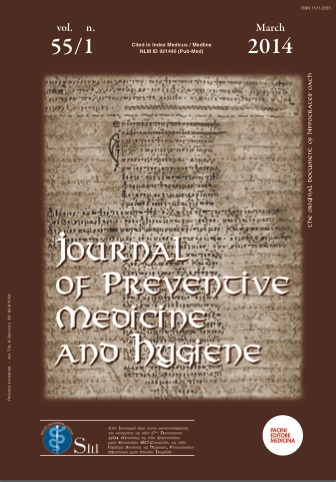Abstract
Introduction. Sexually transmitted infections (STIs) are considered a serious public health problem worldwide, affecting especially young people. The international monitoring data indicate that 70% of patients with STIs are aged between 15 and 24 years and the World Health Organization estimates that one out of 20 teenagers contracts an STI each year. We wanted to evaluate, through this work, what high school students of Messina know about the STIs. Material and methods. From February to May 2013 questionnaires were distributed to students of the last three classes of seven high schools, three of which belonging to humanistic area and four to technical area. The completed questionnaires collected were 1588. Results and discussion. The investigation carried out showed a better knowledge of the STIs by students of humanistic schools than students of technical-scientific schools, the percentage of correct answers was 74% and 60% respectively; this probably also depends on the family context, in fact, there is a statistically significant correlation between the percentage of correct answers and parents education level. Young people have a limited knowledge on the subject. We concluded our work by stressing the importance and the need to deepen and improve the training and information of the medical staff, teachers and families, as it is from their knowl- edge and their ability to provide complete and accurate information about the risks posed by STIs that can derive knowledge and choices of appropriate lifestyle between the youth population.References
Epi Info 2002. Epidemiological and statistical program developed by CDC Atlanta and WHO.
Fergus S, Zimmerman MA, Caldwell CH. Growth trajectories of sexual risk in adolescence and young adulthood. Am J Public Health. 2007;97:1096–1101.
Samkange-Zeeb FN, Spallek L, Zeeb H. Awareness and knowledge of sexually transmitted diseases (STDs) among schoolgoing adolescents in Europe: a systematic review of pubblisced literature. BMC Public Health. 2011;11:727–727.
Trani F, Gnisci F, Nobile CG, et al. Adolescents and sexually transmitted infections:knowledge and behaviour in Italy. J Paediatr Child Health. 2005;41:260–264.
Arnold CA, Limketkai BN, Illei PB, et al. Syphilitic and lymphogranuloma venereum (LGV) proctocolitis: clues to a frequently missed diagnosis. Am J Surg Pathol. 2013;37:38–46.
PHLS, DHSS & PS and the Scottish ISD (D)5 Collaborative Group , author. Trends in sexually transmitted infections in the united kingdom 1990-1999. Public Health Laboratory Service: London; 2000.
Simms I, Stephenson JM. Pelvic inflammatory disease epidemiology; what do we know and what do we need to know? Sex Transm Infect. 2000;76:80–87.
Panchaud C, Singh S, Feivelson D, et al. Sexually transmitted diseases among adolescents in developed countries. Fam Plann Perspect. 2000;32:24–32.
Bozon M, Kontula O. Sexual behaviour and HIV/AIDS in Europe. In: Hubert M, Bajos N, Standford T, editors. Sexual Initiation and Gender in Europe. London: UCL Press; 1998. pp. 37–67.
Adler MW. Sexually transmitted infections in Europe. Eurohealth. 2006;12:3–6.
Kangas I, Andersen B, McGarrigle CA, et al. A comparison of sexual behaviour and attitudes of healthy adolescents in a Danish high school in 1982, 1996 and 2001. Popul Health Metr. 2004;2:5–5.
Merakou K, Costopoulos C, Marcopoulou J, et al. Knowledge, attitudes and behaviour after 15 years of HIV/AIDS prevention in schools. Eur J Public Health. 2002;12:90–93.
Kegeles SM, Adler NE, Irwin CE. Adolescents and condoms. Associations of beliefs with intentions to use. Am J Dis Child. 1989;143:911–915.
Persson E, Sandstrom B, Jaribro G. Sources of information, experiences and opinions on sexually, contraception and STD protection among young Swedish students. Adv Contracept. 1992;8:41–49.
Editorial Team , author. Young people's knowledge of sexually transmitted infections and condom use surveyed in England. Euro Surveill. 2005;10:E050804.3–E050804.3.
Caetano ME, Linhares IM, Pinotti JA, et al. Sexual behaviour and knowledge of sexually transmitted infections among university students in Sao Paulo, Brazil. Int J Gynaecol Obstet. 2010;110:43–46.
Pedlow CT, Carey MP. HIV Sexual risk-reduction interventions for youth: a review and methodological critique of randomized controlled trials. Behav Modif. 2003;27:135–190.
Okonkwo JEN, Obionu C, Uwakwe R, et al. Sources of sexual information and its relevance to sexual behavior in Nigeria. West Afr J Med. 2002;21:185–187.
Aboyeji AP, Adegoke AA, Adebisi SA. Sexual behaviour and knowledge of sexually transmitted diseases among female adolescents in Ilorin Kwara State. Tropical Journal of Medical Research. 2004;8:10–16.
Mwambete KD, Mtaturu Z. Knowledge of sexually transmitted diseases among secondary school students in Dar es Salaam, Tanzania. Afr Health Sci. 2006;6:165–169.
Grosskurth H, Mosha F, Todd J. Impact of improved treatment of sexually transmitted diseases on HIV infec- tion in rural Tanzania. Randomized controlled trial. Lancet. 1995;346:630–636.
Coyle K, Kirby D, Parcel G, et al. Safer choices: A multicomponent school-based HIV/STD and pregnancy prevention program for adolescents. J Sch Health. 1996;66:89–94.
Applegate M. AIDS education for adolescents: a review of the literature. Journal of HIV/AIDS Prevention and Education for Adolescents and Children. 1998;2:5–29.
Ziglio E, Hagard S, Griffiths J. Health Promotion International. 2. Vol. 15. Oxford University Press; 2000. Health promotion development in Europe: achievements and challenges.
DiClemente RJ. Preventing HIV/AIDS among adolescents: schools as agents of behavior change. JAMA. 1993;270:760–762.


